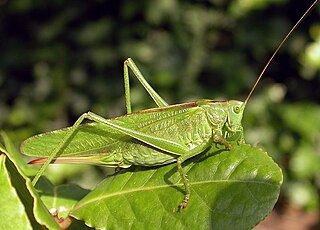
The Tettigoniinae are a subfamily of bush crickets or katydids, which contains hundreds of species in about twelve tribes.

Macroxiphus is a small genus of bush crickets or katydids distributed in Southeast Asia and Micronesia. The nymphs of the insects mimic ants.

The subfamily Pseudophyllinae contains numerous species in the family Tettigoniidae, the katydids or bush crickets. Sometimes called "true katydids", together with the crickets of suborder Ensifera, they form part of the insect order Orthoptera which also contains grasshoppers.

Zabalius is a genus of bush crickets or katydids in the subfamily Pseudophyllinae. Its distribution is essentially Afrotropical. They are generally heavily built, tree-dwelling herbivorous katydids, capable of flight.
Acilacris is a genus of shieldback katydids in the subfamily Meconematinae, found in southern Africa. It contains two subgenera, Acilacris and Aroegas, and nine species:
Africariola is a monotypic genus in the family Tettigoniidae found in southern Africa. The single species is A. longicauda, the Richtersveld katydid.

Mecopodinae, the long-legged katydids, are a subfamily of bush crickets found in western South America, sub-Saharan Africa, and Asia. In Asia, the distribution includes India, Indochina, Japan, the Philippines, and Malesia to Papua New Guinea and Australasia, including many Pacific islands.
Sopatas' black-kneed katydid is a species of katydid that is endemic to the Klein karoo biome of Western Cape province in South Africa. It is threatened by overgrazing by livestock and changes in weather patterns affecting its microhabitat.

The Copiphorini are a tribe of bush crickets or katydids in the family Tettigoniidae. Previously considered a subfamily, they are now placed in the subfamily Conocephalinae. Like some other members of Conocephalinae, they are known as coneheads, grasshopper-like insects with an extended, cone-shaped projection on their heads that juts forward in front of the base of the antennae.
Aprosphylus hybridus, the Namibian black-kneed katydid, is a species of katydid that is endemic to southern Namibia.

Typophyllum is a genus of leaf-mimicking katydids belonging to the family Tettigoniidae.

Conocephalinae, meaning "conical head", is an Orthopteran subfamily in the family Tettigoniidae.

Agraeciini is a large tribe of bush crickets or katydids in the conehead subfamily, Conocephalinae.

Copiphora rhinoceros, the rhinoceros katydid, is a katydid found in Central America. It belongs to a group known as the conehead katydids and can be identified by a horn-like projection on the center of its head. The horn is used to ward off attacks from hungry bats. Unlike most katydids, which are herbivores, the rhinoceros katydid is an omnivore, feeding on fruit, seeds, invertebrates and small lizards. Its lifespan is one to two years.

Copiphora is a large genus of large katydids within the katydid subfamily Copiphorinae.

The Pterochrozinae are a subfamily of the Tettigoniidae found in Central and South America. They were previously placed as a tribe in the subfamily Pseudophyllinae and have been called "leaf-mimic katydids".
Naskreckia is a genus of South African bush crickets belonging to the tribe Meconematini.
Ceresia pulchripes, the common ceresia, is a species of bush cricket or katydid endemic to South Africa. It is the only species in the genus Ceresia.

Orophus is a small genus of katydids native to Mexico, Central America, and South America.

Moncheca is a genus of conehead katydids containing at least four species.










